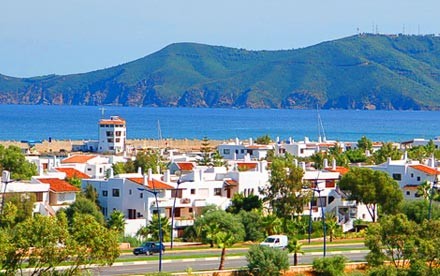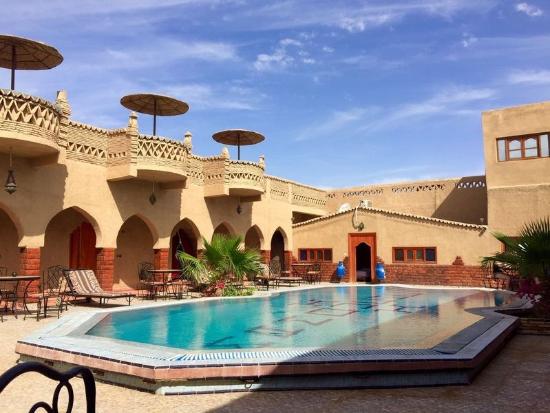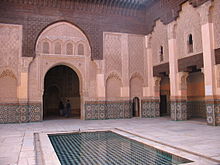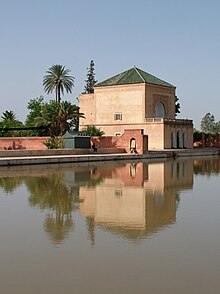Tetouan is one of the nicest cities in Morocco. Great beaches and a good reputation makes this a must-visit city for every tourist. The beautiful setting, modern streets and around the clock activities make this city a number one attraction.
The city of Tetouan in the northern part of Morocco means ‘open you eyes’ in the Berber language. The name probably was derived by the hasty development of the town by the Muslim and Andalusian refugees of Spain. It is the only open port of Morocco on the Mediterranean Sea. Perched atop the slope of a narrow valley with a huge dark mass rock, the city has a very beautiful setting. It is surrounded by the majestic mountains in the south and the west. It is just about 40 miles from the city of Tangier. It has nearly a population of 320,539 as per 2004 figures. You will find the Moroccan Darija Arabic and the Berber Tamazight languages being used by the locals in their daily life. Arabic is the official language and you will also find business people using Spanish as well as French.
History
The city was founded in the 3rd century BC. Artifacts from the Roman and Phoenician eras are known to exist in the site of Tamuda. It was built around 1305 by the Marinid King Abu Thabit from where attacks were carried out on the Ceuta. It was destroyed in 1400 when it came to be known as a safe haven for the pirates. It was rebuilt in the 15th century by the refugees of 'reconquista'. The Andalusian Moors built fortifications before developing the city. In 1860 it was taken over by the Spaniards under Leopoldo O’Donnell. It was evacuated on May 2nd 1862. However, the Moors had so much hatred that they destroyed the entire city and got it to its former bad state. It was formerly ruled by Spain and came under the Spanish protectorate in 1913 governed by Jalifa. You can find the Spanish influence even now with street name in Arabic and Spanish and some people even speaking Spanish.
The Muslim population is the majority one but the Sephardi Jewish community that emigrated from Spain after 'reconquista’ has also been here in minority for a long time.
What to see?
As you come to the city of Tetouan you will find that it is located between a variety of orchards of orange, almond, pomegranate and cypress trees. This is a part of the Martil Valley which flows down with Tetouan, Martil harbor at its mouth. Within the city you can find it interesting to explore the wonderful fountains and orange groves in the magnificent houses of the aristocratic Arabs who are the descendants of those expelled from Al-Andalus by the European 'reconquista’. Their houses are superb with exquisitely carved ceilings painted in hispano-moresque designs. You would also find the peculiar Tetuan tile work on the floors, pillars and dados. You feel the Moorish impact of Sevilla, Andalusian and Cordoba towns on the architecture here.
It’s worth a visit to the traditional industries involved in creation of tile work, inlaying with silver wire as well as the manufacturers of thick soled yellow slippers, flintlocks, and capes and skirt for girls in rural areas. You can find the goutahs and babouches the two traditional items worn by Berber here. The souks are particularly active and you can find small squares devoted to local foods and crafts and selling a wide variety of local pottery. There are number of monuments that you can visit in Tetouan; the Khalifa’s old palace just outside the medina, a fort, ancient walls and preserved fences, mosques, fountains and foundouks that give the city a very interesting look. Even if you go around the city’s winding streets you would discover among the walls a wonderful world telling you some interesting part of the history. The median in Tetouan is listed as a World Heritage site by UNESCO and is worth a visit.
Accommodation, eat and drink
The beaches between the Ceuta and Tetouan are the most beautiful beaches of Morocco which you cannot afford to miss. There are luxury hotel and bungalows where you may stay near the beaches where you may stay. Within the city also there are several luxury hotels as well as good budget hotel. Many of them even have some rooms with rooftop terrace that have some great views. Most of them are comfortable designed to make your stay peaceful and relaxing. If you want to eat there are several hotels with their own specialties serving authentic Moroccan cuisine. There are various facilities like bars, swimming pools and spas to give you ultimate luxury. The staff like the people around the town is extremely friendly and helpful.
The city of Tetouan is a busy and active town and very exiting to visit. The shopping areas and the old monuments are attractive and thorough exploration can bring up many surprises that will give you a feeling of a successful trip to Morocco.





































